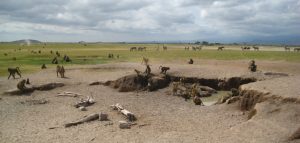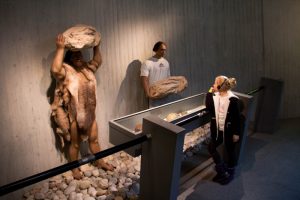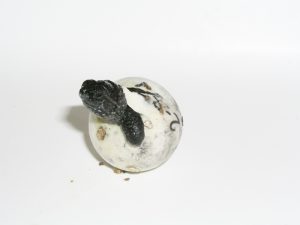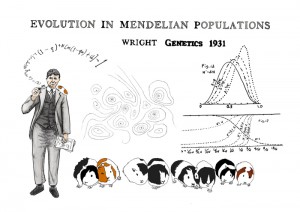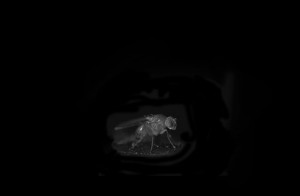Enter your address to receive notifications about new posts to your email.
Articles tagged Population Genetics
(72 results)
-
Kimura & Crow: Infinite alleles
For two weeks in the summer of 1953, Motoo Kimura enjoyed a welcome respite from loneliness and the austerity of post-war Japan. Crossing the Pacific from Yokohama to Seattle to commence PhD studies at Iowa State University, Kimura played deck golf, enjoyed full service meals, and napped to the soothing vibrations of the venerable passenger…
-
#TAGC16 Shorts: the bursting bubble of harmful mutations
Guest post by Tyler Kent. #TAGC16 Shorts are brief summaries of presentations at The Allied Genetics Conference, a combined meeting of seven genetics research communities held July 13-17, 2016 in Orlando, Florida. Purging harmful mutations is the most common task of natural selection. In non-recombining populations this background selection process represents the “survival of the…
-
#TAGC16 Shorts: evolution on ecological timescales
Guest post by Julia Kreiner. #TAGC16 Shorts are brief summaries of presentations at The Allied Genetics Conference, a combined meeting of seven genetics research communities held July 13-17, 2016 in Orlando, Florida. A common perception of evolution sees only slow and consistent genetic change over thousands of generations. But geneticists are increasingly shedding light on…
-
Fast-growing bacteria doom their colonies’ attempts at resistance
Lurking in colonies of pathogenic bacteria are drug-resistant mutants. If the colony is exposed to antibiotics, these resistant mutants may survive, but they still face the challenge of recolonizing the host. Their success in this task depends on their diversity; a diverse population is more likely to harbor mutants that can withstand a second threat,…
-
Selfish self-fertilization hampers adaptation
When finding a mate is difficult, self-fertilization offers a tempting solution by increasing the number of offspring an individual can produce. But although “selfing” provides a stopgap solution when mates are scarce, it is frequently an evolutionary dead end; when environmental conditions change, species with high selfing rates seem prone to extinction. In an article…
-
Fecal alchemy: Turning poop into genomics gold
When it comes to genotyping technology, poop genetics is stuck in the 1990s. While most geneticists are now awash in genome-scale data from thousands of individuals, those who depend on fecal and other non-invasively collected samples still rely on old-school, boutique panels of a dozen or so genetic markers. But feces — along with fur,…
-
Inbred Neanderthals left humans a genetic burden
The Neanderthal genome included harmful mutations that made the hominids around 40% less reproductively fit than modern humans, according to estimates published in the latest issue of GENETICS. Non-African humans inherited some of this genetic burden when they interbred with Neanderthals, though much of it has been lost over time. The results suggest that these harmful…
-
First gene linked to temperature-dependent sex determination
The sex of many reptile species is set by temperature. New research reported in the journal GENETICS identifies the first gene associated with temperature-dependent sex determination in any reptile. Variation at this gene in snapping turtles contributes to geographic differences in the way sex ratio is influenced by temperature. Understanding the genetics of sex determination…
-
Dobzhansky: Bug collecting and the Modern Synthesis
In 1917, amidst the turmoil of the Russian Revolution, a bug-obsessed teenager in Kiev discovered a new species of ladybird beetle in the debris washed up on the banks of the flooding Dnieper River. The following year, he described the species in his first scientific publication. That 18-year old ladybug spotter —Theodosius Dobzhansky— would go…
-
Sewall Wright: Evolving Mendel
In 1931, Sewall Wright—a quiet American geneticist specializing in livestock and guinea pigs—published a GENETICS paper that changed how we study evolution. Wright’s “Evolution in Mendelian populations” was one of the founding documents of population genetics and was among the first formal frameworks to reconcile Mendel’s laws of inheritance with Darwin’s vision of natural selection.…
-
The evolution of Dark-fly
On November 11, 1954, Syuiti Mori turned out the lights on a small group of fruit flies. More than sixty years later, the descendents of those flies have adapted to life without light. These flies—a variety now known as “Dark-fly”—outcompete their light-loving cousins when they live together in constant darkness, according to research reported in…


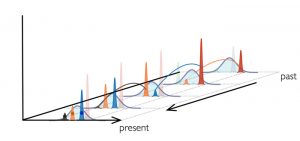

![This colorized version of PHIL 232 depicts a scanning electron micrograph (SEM) of a number of Pseudomonas aeruginosa bacteria. Photo and caption credit: Janice Haney CarrContent Providers(s): CDC/ Janice Haney Carr [Public domain], via Wikimedia Commons.](https://s36063.pcdn.co/wp-content/uploads/2016/07/rsz_1pseudomonas-300x211.jpg)
![Helonias bullata, a species threatened with extinction. Its low genetic diversity, a factor contributing to its decline, may have been caused by a high rate of self-fertilization. By Hedwig Storch (Own work) [CC BY-SA 3.0 (http://creativecommons.org/licenses/by-sa/3.0)], via Wikimedia Commons.](https://s36063.pcdn.co/wp-content/uploads/2016/07/1024_Helonias_bullata_Arktisch-alpiner_Garten_Chemnitz-0931-e1467579681557-300x197.jpg)
